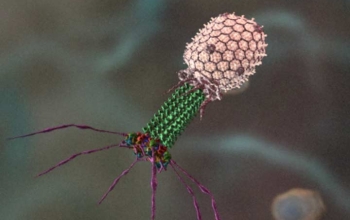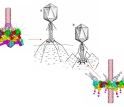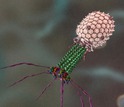News Release 04-105
Viruses on the Attack
Revealing visuals show details of a common mechanism for infection

The bacteriophage T4 is preparing to infect its host cell. The structure of bacteriophage T4 is ...
August 20, 2004
This material is available primarily for archival purposes. Telephone numbers or other contact information may be out of date; please see current contact information at media contacts.
ARLINGTON, Va.—Using a combination of imaging techniques, researchers have determined the mechanics that allow some viruses to invade cells by piercing their outer membranes and digesting their cell walls. The researchers combined their findings with earlier studies to create a near-complete scenario for that form of viral assault.
The results have a dual benefit: they show the inner workings of complex, viral nanomachines infecting cells (in a process nearly identical to some viral infections of human cells) and the images provide design tips for engineers hoping to build the gene delivery devices of the future.
The study, by researchers from Purdue University and the Shemyakin-Ovchinnikov Institute of Bioorganic Chemistry in Moscow, appears in the August 20, 2004, issue of Cell.
Led by Michael Rossmann and Vadim Mesyanzhinov, the team added their findings to several decades of research into the structure of bacteriophage T4 – a virus that attacks the familiar pathogen Escherichia coli (E. coli). The work was supported by grants from the National Science Foundation, The Human Frontier Science Program and the Howard Hughes Medical Institute.
Although some strains of E. coli can cause food poisoning, other strains supply essential products to the human gut. It is possible that studies of viruses could one day help biologists develop strategies to fight deadly bacterial infections. Similar efforts targeting antibiotic-resistant bacteria are already underway in other laboratories.
The researchers combined x-ray crystallographic data, which gives 3-D atomic details of the constituent viral proteins, with cryo-electron microscopy images to determine how proteins in the T4 phage rearrange themselves during cell infection. Cryo-electron microscopy is similar to standard electron microscopy, except the specimens are first frozen to slow down radiation damage and hence improve the clarity of the images.
By combining thousands of images of the virus viewed from different directions, the researchers were able to determine a three dimensional structure at about 17 Ångstrom resolution, a distance spanned by just a few atoms. The end result is a model of how bacteriophage T4 infects cells.
Now that the researchers have established relationships between the component proteins, they will be analyzing the conformational changes that occur during infection. As part of their continuing work, the researchers are also looking at similar processes in other viruses to determine common essential features and differences related to the specific adaptation of each virus type.
From the researchers:
"The work opens up the door to further application of ‘hybrid’ techniques such as we used by combining crystallography and electron microscopy" – Michael Rossmann, Hanley Professor of Biological Sciences at Purdue University
"The results give hope that viruses might be targeted to find specific cells where they would then inject the cell with a genome that included useful new genes for the targeted cell." – Michael Rossmann
"The work is an excellent example of what can be achieved by a team effort, where each person plays a critical and vital role. We were extremely fortunate to have extraordinarily talented scientists such as Petr Leiman and Victor Kostyuchenko as well as equally talented participation of Paul Chipman who did all the electron microscopy data collection." – Michael Rossmann
From experts at NSF:
This discovery is a perfect example of how basic research may lead to an eventual medical breakthrough." -- Kamal Shukla, Program Director for Molecular Biophysics, National Science Foundation
"Dr. Rossmann's pioneering research also demonstrates the power of combining two biophysical methods, cryo-electron microscopy and x-ray crystallography, and how this approach can provide new insights that may not be obtained from a single methodology." -- Kamal Shukla
"This work shows, at the atomic level, how a bacteriophage can break through a bacterial cell wall. Researchers are using the bacteriophage components that specialize in dissolving as the core of a new and emerging strategy to fight bacterial pathogens, especially microbes that have developed resistance to traditional antibiotics." – Patrick Dennis, Program Director for Microbial Genetics at the National Science Foundation
"Viruses – these beautiful machines – are showing us how to develop nanotechnologies with a broad range of applications." – Parag Chitnis, Program Director for Molecular Biochemistry at the National Science Foundation
Purdue University release available at:
http://news.uns.purdue.edu/UNS/html4ever/2004/040820
.Rossmann.baseplate.html
-NSF-
-
The left panel shows the structure of the bacteriophage T4 baseplate in the hexagonal conformati ...
Credit and Larger Version -
View Video
This animated video depicts bacteriophage T4 infecting its host cell.
Credit and Larger Version
Media Contacts
Josh Chamot, NSF, (703) 292-7730, email: jchamot@nsf.gov
Chad Boutin, Purdue University, (765) 494-2081, email: cboutin@purdue.edu
Program Contacts
Kamal Shukla, NSF, (703) 292-8444, email: kshukla@nsf.gov
Parag Chitnis, NSF, (703) 292-8441, email: pchitnis@nsf.gov
Patrick Dennis, NSF, (703) 292-8441, email: pdennis@nsf.gov
Principal Investigators
Michael Rossmann, Purdue University, (765) 494-4911, email: mgr@indiana.bio.purdue.edu
Related Websites
High-resolution video available at: http://seyet.com/t4phage/leiman-et-al.movie-2.mov
Additional virus movies: http://bilbo.bio.purdue.edu/~viruswww/Rossmann_home/movies.shtml
The Rossmann Laboratory at Purdue University: http://bilbo.bio.purdue.edu/~viruswww/Rossmann_home/index.shtml
The U.S. National Science Foundation propels the nation forward by advancing fundamental research in all fields of science and engineering. NSF supports research and people by providing facilities, instruments and funding to support their ingenuity and sustain the U.S. as a global leader in research and innovation. With a fiscal year 2023 budget of $9.5 billion, NSF funds reach all 50 states through grants to nearly 2,000 colleges, universities and institutions. Each year, NSF receives more than 40,000 competitive proposals and makes about 11,000 new awards. Those awards include support for cooperative research with industry, Arctic and Antarctic research and operations, and U.S. participation in international scientific efforts.
Connect with us online
NSF website: nsf.gov
NSF News: nsf.gov/news
For News Media: nsf.gov/news/newsroom
Statistics: nsf.gov/statistics/
Awards database: nsf.gov/awardsearch/
Follow us on social
Twitter: twitter.com/NSF
Facebook: facebook.com/US.NSF
Instagram: instagram.com/nsfgov




